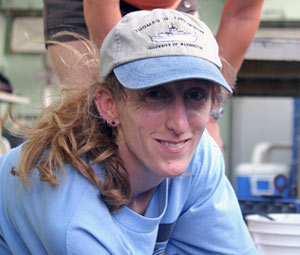Interview: Biologist Stace Beaulieu
 Stace Beaulieu, a state spelling bee champion turned scientist, once lost an eighth grade competition after tripping on the word “haddock.” “Can you believe I’m a marine biologist,” she said, “and I misspelled the name of a fish?” Today she says spelling, and a solid command of English, is helpful for successful biology research at WHOI. A big plus: “I rarely have to use spell check when I’m writing a paper.” Stace Beaulieu, a state spelling bee champion turned scientist, once lost an eighth grade competition after tripping on the word “haddock.” “Can you believe I’m a marine biologist,” she said, “and I misspelled the name of a fish?” Today she says spelling, and a solid command of English, is helpful for successful biology research at WHOI. A big plus: “I rarely have to use spell check when I’m writing a paper.”
Where did you grow up and how did that place influence your interest in ocean science?
I grew up in South Florida, in Palm Beach Gardens. When I was about 6 or 7 years old, I started snorkeling with a friend and her family. Ever since then, I wanted to be a deep-sea diver because I learned about this whole new world to explore. Basically I had my career picked out before I was 10 years old.
In high school in the mid-1980s you were the Florida state spelling champion. How has good spelling helped in your science career?
I rarely have to use spell check when I’m writing a paper. It also helps me understand words from all languages; keep in mind that as a teenager I used to read the dictionary, so I really got a solid command of the language. Knowing how to spell also makes me unstoppable in word games.
What makes you excited to be a scientist?
I love the aspect of discovery, and also of understanding nature. I am always thrilled by the diversity of life in the sea, and the interactions among different species.
Who was most influential person in your career, and why?
Two people were most influential in my scientific career. First, Patty Webb was my sponsor at the University of Florida during a summer science training program while I was in high school. At a time when I was looking for female role models in science, Patty helped me learn how to develop scientific questions and then present science to different audiences. Second, Ken Smith was my graduate advisor at Scripps Institution of Oceanography. He is an excellent scientist with incredible sea-going skills. I learned so much from Ken about conducting oceanographic research at sea.
What stands out as your favorite moment in the science discovery process?
During my first dive in the submersible Alvin, I was diving at 4,000 meters (13,200 feet) off central California. Incredibly, my dive coincided with an event in which the sea floor was carpeted with phytodetritus—basically, waste that comes from phytoplankton living in the water column. Tons of fluffy, green material was sinking all the way to the sea floor and providing a major food source to the animals. It was amazing to see this happening.
What is your role on this cruise?
I am working with Yuri Rzhanov, Adam Soule, and Tim Shank on a project to take video images of the seafloor at Rosebud and Mussel Bed. We compile individual video frames to form mosaics, or large-scale images of the seafloor.
What will you do with that information?
The mosaics will be input to a GIS (Geographic Information System) that Adam created with data and images from several previous cruises to the Galapagos Rift. For this cruise and these study sites, we will make mosaics of areas that have been photographed and videotaped on previous cruises so that we can understand changes in the seafloor community structure over the last few decades. We also want to make the mosaic software user-friendly, so that scientists on future cruises will be able to make their own mosaics of their study sites.
In addition to science, athletics are a big part of your life. You have competed in 13 marathons (26.2 mile running races), including the prestigious Boston marathon just four weeks before this expedition. How do you keep in shape at sea?
We are lucky on Atlantis to have a treadmill as well as some other exercise equipment so that we can get some aerobic exercise. However, I am betting that our schedule will be very packed on this cruise. I might have time for only a few runs.
This is a physics question, about motion: How do you keep from flying off the treadmill when waves toss the ship?
I recommend running slower than your usual pace until you get used to the weird feeling of your weight being very light (when the ship pitches forward) or very heavy (when the ship pitches back). Also, don’t run more than 20 minutes the first time, because you are very likely to feel seasick.
[Back to main interviews page]
|

